Abstract
In this paper a single-channel chirped pulse amplification laser system based on Yb-doped photonic crystal fiber was constructed, which achieved a pulse energy output of 1 mJ with a beam quality close to the diffraction limit. Pulsed synchronous pumping was used to suppress amplified spontaneous emission at a repetition rate of 1 kHz. The de-chirped pulse width of 231 fs was achieved by precise systematic dispersion control, and the corresponding peak power reached 3.85 GW.
1. Introduction
High energy femtosecond lasers are widely used in many industrial and academic fields [1,2,3]. In industry, femtosecond lasers have become mature instruments in material processing and surgical units. In academia, it has been an enabling tool in many time-resolved fields, including 2D spectroscopy, transient absorption spectroscopy and ultra-fast electron diffraction [4,5,6]. In addition, the short pulse width and high peak power of femtosecond pulses are the key to driving nonlinear optical processes. For example, high energy physics, such as laser particle acceleration [7], requires femtosecond pulses with high peak power and large energy. On the one hand, in order to obtain such required output parameters, fiber femtosecond lasers are widely acclaimed for their high average power capability, relatively simple setup, and excellent beam quality. On the other hand, the combination of chirped pulse amplification (CPA) [8] and large mode area (LMA) fiber solutions [9,10] can significantly improve the achievable performance. Their potential has been well exploited in the past few decades. At present, the average power of the femtosecond fiber laser can be kilowatt level and the beam quality approximates the diffraction limit [11]. However, extracting ultra-short laser pulses with a high peak power is significantly more challenging than bulk laser systems because the high intensity in the fiber core lasts for a fairly long interaction time, which leads to nonlinear distortions of pulse mainly caused by self-phase modulation (SPM). The high pump absorption of ytterbium doped fibers (YDF) results in a rather short amplifier design, which helps to reduce nonlinear phase accumulation. Fiber CPA systems using a Yb-doped LMA step-index fiber as the main amplifier with a pulse energy of more than several 100 μJ was proposed many years ago [12,13]. In order to further reduce nonlinearity, it is necessary to increase the area of the mode field in fiber amplifiers. The increase of core size results in the loss of single-mode behavior of the amplifier. For flexible fibers, the higher modes can be suppressed by the correct pattern matching of seed injection and the appropriate bend fiber. Another solution is to use very large core, rod-type fibers, and suppress higher-order modes by using photonic crystal arrays. Photonic crystal fiber (PCF) amplifiers have been successfully used in systems with high pulse energy [14,15,16]. Eidam et al. realized the output result of a single pulse energy of 2.2 mJ and a compressed pulse width of 480 fs by using a large-pitch PCF [17], but it introduced many space elements, which reduced the reliability of the system. Moreover, the accumulated nonlinear effects worsened the compression quality. Although a narrower pulse width (<100 fs) can be achieved by using nonlinear chirped pulse amplification [18,19,20,21], the energy achieved is limited by the bandwidth of gain medium, which is only in the order of μJ.
In this paper, we established a CPA system based on a large mode area rod-type Yb-doped PCF. Double chirped Bragg grating (CFBG) was used to stretch the pulse whose second and third order dispersion could be accurately adjusted to match the compressed grating pair to obtain good compression quality. The mode matching of each amplifying stage ensured no beam distortion, and pulsed synchronous pumping was used to suppress amplified spontaneous emission (ASE). This laser generated a pulse width of 231 fs at a repetition frequency of 1 kHz. Its pulse energy was 1 mJ and the peak power was up to 3.85 GW.
2. Experiment Setup
The structure diagram of the laser is shown in Figure 1. The optical fiber and optical devices in the system adopted a polarization maintaining (PM) structure to ensure the output was linearly polarized. The seed source was an all-normal-dispersion fiber oscillator mode-locked by using a nonlinear amplification loop mirror, which was introduced in more detail in our previous work [22]. The output pulse had a repetition rate of 8.7 MHz, a pulse width of 35 ps, and a spectral width of 25 nm.
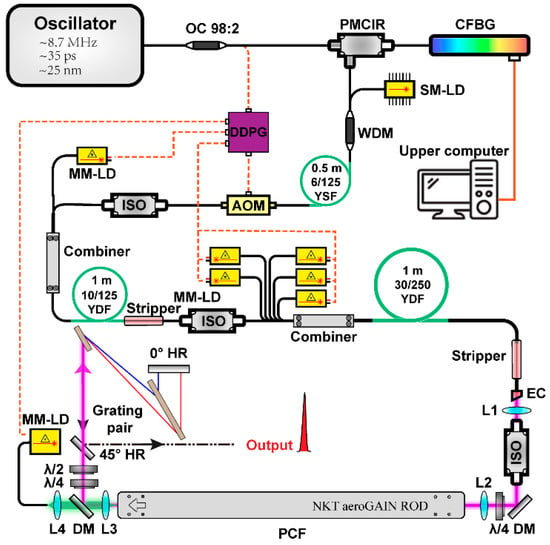
Figure 1.
Schematic of the FCPA system. PMCIR: polarization maintaining optical circulator, OC: optical coupler, CFBG: chirped fiber Bragg grating, WDM: wavelength-division multiplexer, SM/MM-LD: single/multimode laser diode, AOM: acoustic optical modulator, DDPG: digital delay and pulse generator, ISO: isolator, YDF means Yterbium doped fiber, PCF: photonics crystal fiber, DM: dichroic mirror EC: end cap, HR: high-reflectivity mirror, λ/4, quarter-wave plate; λ/2, halfwave plate.
Two percent of the seed light was used to trigger the digital delay and pulse generator (DDPG) by using an optical coupler and provide a reference signal for the subsequent repetition rate drop, synchronous pumping and autocorrelator detection. The remaining 98 percent of the seed light was injected into the stretcher, where dual CFBG with a bandwidth of 24 nm was applied. The group velocity dispersion (GVD) and third-order dispersion (TOD) it provided were 39.83 ps2 and −0.59 ps3, respectively. The seed pulse was stretched from 35 ps to 1.46 ns, as shown in Figure 2a. The loss of the CFBG and the optical circulator was compensated by a stage of preamplifier, in which the 0.5 m long gain fiber, highly Yb-doped single-mode fiber (PM-HI-YSF), was continuously pumped with 1 W, 976 nm laser diode (LD). Then, the repetition rate was reduced to 1 kHz through a fiber acousto-optic modulator (AOM). The pulse energy was enhanced by the subsequent two-stage fiber boost amplifier. In the first boost amplifier, the 1 m long gain fiber (PM-10/125-YDF) was synchronously pulse-pumped by a 25 W, 976 nm multimode laser diode (MMLD). In the second boost-amplifier, 1 m long PM-30/250-YDF was used as gain fiber which was bent with a curvature radius of 5 cm to increase the loss of the higher-order mode and suppress the higher-order mode in the gain competition. Pulse pumping was performed using five 25 W, 976 nm MMLDs combined with a (6 + 1) × 1 fiber combiner. All the fiber combiners used in the laser were made of pre-taper technology, which can prevent the stress unit from being destroyed during the drawing process, thus avoiding the problem of spectral modulation caused by the combiner, and controlling the spectral shape of all levels before each main amplifier without distortion. After each fiber amplifier, a fiber isolator was added to prevent the return light damaging the optical devices of the previous stage. In addition, fiber strippers were added between the amplifying stages to leak the residual pump light into the fiber cladding. The output end of the second boost amplifier was welded with an end cap at an oblique cut angle of 8° to prevent the high energy density from damaging the optical fiber end face on the one hand and suppress parasitic oscillation on the other hand. The structure before the main amplifier was similar to our previous work [23], but the pulse width was stretched wider in order to obtain higher energy.
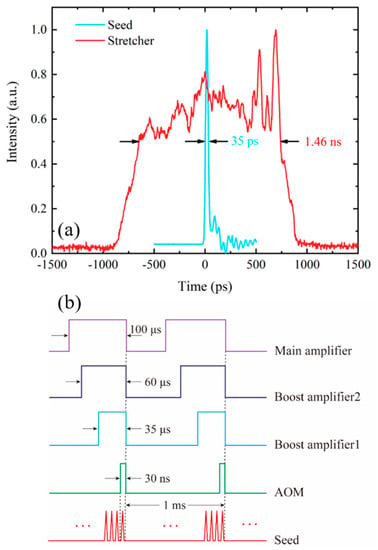
Figure 2.
(a) Seed pulse (blue line) and stretched pulse (red line), (b) schematic diagram of timing sequence at all stages of the system.
The main amplifier employed the Rod-type PCF gain module integrating water cooling (aero GAIN-ROD Module-2.1) produced by NKT, the fiber length was 0.8 m and the diameter of the fiber core and cladding were 85 μm and 260 μm, respectively, the corresponding mode field area was about 3500 μm2, the numerical aperture (NA) was 0.03. The absorption coefficient was 15 dB/m at 976 nm. Two symmetrical stress bars ensured that the polarization state of the light pulse did not change. The output light from the 30/250 amplifier was collimated by lens 1 (L1), and the spatial optical isolator was used to protect the pre-stage device. Then, the direction of the optical path was changed by a dichromatic mirror (DM), and the cladding pump light was further filtered out. The DM used in the experiment was 45° high reflection near 1030 nm and high transmittance near 976 nm. The spot was then focused into the rod fiber through another lens (L2). In the experiment, the coupling of signal and light had an important effect on the output quality, which not only affected the amplification efficiency, but also affected the beam quality and then affected the compression of the grating pair. In order to match the mode field and NA of the PCF, both L1 and L2 were diffraction-limit aspheric lenses. The focal length and NA of L1 were 30 mm and 0.38, respectively. The spot size after collimation was 1.3 mm. The focal length of L2 was 50 mm, and the numerical aperture NA was 0.20. The focus spot diameter was 57μm, which was smaller than the mode field diameter of the PCF, and the coupling efficiency was higher than 82%. The pump adopted the backward pumping scheme. The pump light was also focused through two sets of lenses, and a DM was added in the middle to separate the amplified signal light for compression. A 110 W, 976 nm LD was used as the pump source. The output tail fiber was multimode fiber with a core diameter of 105 μm and NA of 0.22. The pump light was collimated by two diffractive limit aspheric lenses, L4 and L3, with focal lengths of 12.5 mm and 25 mm, respectively. Pulse synchronous pumping was also used in this stage. The timing sequence of each stage is shown in Figure 2b. The width of the AOM gate was 30 ns to ensure the pickup of a single pulse, and the pump pulse width in each amplifier was 35 μs, 60 μs and 100 μs, respectively. High diffraction efficiency gratings (produced by GitterWerk) were used as the compressor, whose diffraction efficiency at 1030 nm was as high as 99.5%. The line density was 1739 line/mm, and the size of the gratings were 137 mm × 31 mm and 30 mm × 25 mm, respectively. The parameters of components are summarized in Table 1.

Table 1.
The parameters of components in the system.
3. Results and Discussion
The output energy at all stages is shown in Figure 3a. After the stretcher, the seed pulse energy decreased somewhat. After the four stages of amplification, the energy was amplified to 1.22 mJ measured by the energy meter (OPHIR Nova II). It can be estimated that the B integral of this system was about 8 rad. The B integral was defined as the maximum phase shift [24]. The output energy was 1 mJ after the compressor, the corresponding total compressed efficiency was 82 %. In order to estimate the proportion of ASE in the output energy, we injected 100 μs pulse pump in the main amplifier without signal light. The energy we measured was only 0.3 μJ, far less than 1 mJ. So, the ASE energy can be ignored. The spectral evolution of the system is shown in Figure 3b. The spectral evolution was measured by OSA (YOKOGAWA AQ6370D). The spectral bandwidth of the seed pulse was cut to 21 nm due to the CFBG, and narrowed to 11 nm after subsequent four stage amplification because of gain narrowing effect, and the corresponding Fourier transform limit pulse width was 143 fs. In the experiment, the vertical spacing of the compressor gratings was set as 300 mm, and the incident angle was 63.6°. The GVD and TOD provided by the compressor grating pair were −39.75 ps2 and 0.5926 ps3, respectively. The total fiber length in the system was about 28 m, the corresponding introduced dispersion were about 0.644 ps2 and 1.23 × 10−3 ps3. In this case, if the total dispersion of the system is perfectly matched, the amount of dispersion required by CFBG should be: 39.11 ps2 and −0.5938 ps3. However, due to the influence of the SPM effect in the system, the dispersion of CFBG at this point was not the setting for the optimal compression. The nonlinear effect of the CPA system could be compensated for by an appropriate positive dispersion mismatch [25]. Therefore, the GVD and TOD of CFBG were appropriately increased to achieve the narrowest compressed pulse width.
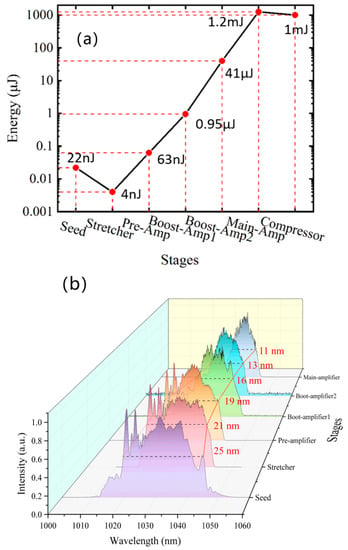
Figure 3.
(a) Evolution of energy at different stages in the laser, (b) evolution of spectrum at different stages in the laser.
The compression results measured through the autocorrelator (AVESTA AA20DD-30 ps) are shown in Figure 4. The pulse width fitted by the Gaussian curve was 231 fs, the time–bandwidth product can be calculated to be about 0.59. The inset is the interference autocorrelation trace. It can be seen the chirp in the middle region of the pulse was basically compensated. The sidelobe on both sides was caused by the nonlinear effect accumulated in the system. By processing the obtained autocorrelation data, its original pulse shape was obtained. In addition, we integrated the energy over the entire AC window, the peak power was inferred to be 3.85 GW, and about 90% of the energy was concentrated in the main peak.
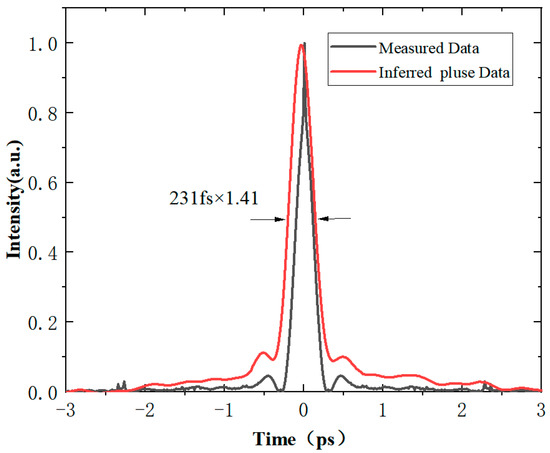
Figure 4.
The autocorrelation trace of compression pulse, and the inset is the corresponding interference autocorrelation trace.
The polarization extinction ratio of the output light was 25 dB. Because the repetition rate of this laser was only 1 kHz, and the pulse synchronous pumping technology was adopted, the system had no obvious heat accumulation, and did not need an additional thermal management control, which not only simplified the whole laser structure, but also improved the stability of the system. The RF curve is shown in Figure 5a. The signal to noise ratio at 1 kHz was higher than 40 dB. In addition, M2 was measured by 4σ method. As shown in Figure 5b, the beam quality of the two axes almost reached the diffraction limit with M2 < 1.25. The M2 of seed was about 1.10, and before the main amplifier the M2 was 1.15. The beam quality maintained high quality transmission in the system.
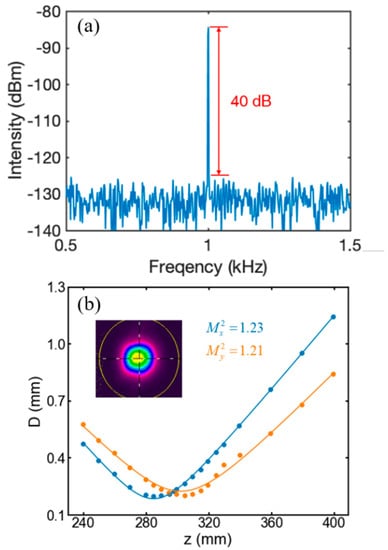
Figure 5.
(a) The radio frequency curve of the compressed pulse, (b) the beam quality factor M2 of the pulse and the spot at the focus.
4. Conclusions
In conclusion, a high-energy Yb-doped fiber CPA laser has been presented. At a low repetition rate of 1 kHz, single pulse energy of 1 mJ was achieved by using synchronous pulse pumping technology, and the output pulse width of 231 fs after compression was achieved through the precise matching of the dispersion-adjustable stretcher and the compressor. The single pulse energy of 1 mJ and the peak power of 3.85 GW with an output pulse width of 231 fs showed quite excellent performance by the single-channel fiber CPA systems. In addition, the output beam quality approximated the diffraction limit, owing to the advantages of PCF. In the future, the average output power can be increased by increasing the repetition rate, and the energy can be further improved by coherent beam-combining technology.
Author Contributions
Conceptualization, H.Z.; methodology, H.Z. and J.Z.; software, D.D.; validation, J.Z., H.X. and J.C.; formal analysis, J.Z..; investigation, D.D.; resources, H.Z.; data curation, J.Z.; writing—original draft preparation, J.Z.; writing—review and editing, H.Z.; supervision, H.Z.; project administration, H.Z. All authors have read and agreed to the published version of the manuscript.
Funding
This research was supported by National Natural Science Foundation of China No.61475081 and Department of Science and Technology of Sichuan Province No.2018JZ0015.
Institutional Review Board Statement
Not applicable.
Informed Consent Statement
Not applicable.
Data Availability Statement
Not applicable.
Conflicts of Interest
The authors declare no conflict of interest.
References
- Nedialkov, N.N.; Imamova, S.E.; Atanasov, P.A. Ablation of metals by ultrashort laser pulses. J. Phys. D Appl. Phys. 2004, 37, 638–643. [Google Scholar] [CrossRef]
- Park, C.; Farson, D.F. Precise machining of disk shapes from thick metal substrates by femtosecond laser ablation. Int. J. Adv. Manuf. Technol. 2016, 83, 2049–2056. [Google Scholar] [CrossRef]
- Chung, S.H.; Mazur, E. Surgical applications of femtosecond lasers. J. Biophotonics 2009, 2, 557–572. [Google Scholar] [CrossRef] [PubMed]
- Cho, M. Coherent Two-Dimensional Optical Spectroscopy. Chem. Rev. 2008, 108, 1331–1418. [Google Scholar] [CrossRef] [PubMed]
- Berera, R.; van Grondelle, R.; Kennis, J.T.M. Ultrafast transient absorption spectroscopy: Principles and application to photosynthetic systems. Photosynth. Res. 2009, 101, 105–118. [Google Scholar] [CrossRef] [PubMed] [Green Version]
- Miller, R.J.D. Femtosecond Crystallography with Ultrabright Electrons and X-rays: Capturing Chemistry in Action. Science 2014, 343, 1108–1116. [Google Scholar] [CrossRef]
- Mourou, G.; Brocklesby, B.; Tajima, T.; Limpert, J. The future is fibre accelerators. Nat. Photonics 2013, 7, 258–261. [Google Scholar] [CrossRef]
- Strickland, D.; Mourou, G. Compression of amplified chirped optical pulses. Opt. Commun. 1985, 56, 219–221. [Google Scholar] [CrossRef]
- Stutzki, F.; Jansen, F.; Otto, H.-J.; Jauregui, C.; Limpert, J.; Tünnermann, A. Designing advanced very-large-mode-area fibers for power scaling of fiber-laser systems. Optica 2014, 1, 233–242. [Google Scholar] [CrossRef]
- Hu, Z.Q.; Yang, P.L.; Teng, H.; Zhu, J.F.; Wei, Z.Y. 1-MHz high power femtosecond Yb-doped fiber chirped-pulse amplifier. Int. Soc. Opt. Photonics 2017, 10619, 106190. [Google Scholar]
- Eidam, T.; Hanf, S.; Seise, E.; Andersen, T.V.; Gabler, T.; Wirth, C.; Schreiber, T.; Limpert, J.; Tünnermann, A. Femtosecond fiber CPA system emitting 830 W average output power. Opt. Lett. 2010, 35, 94–96. [Google Scholar] [CrossRef] [PubMed]
- Galvanauskas, A.; Cho, G.C.; Hariharan, A.; Fermann, M.E.; Harter, D. Generation of high-energy femtosecond pulses in multimode-core Yb-fiber chirped-pulse amplification systems. Opt. Lett. 2001, 26, 935–937. [Google Scholar] [CrossRef] [PubMed]
- Galvanauskas, A.; Sartania, Z.; Bischoff, M. Millijoule femtosecond fiber CPA system. In Proceedings of the Advanced Solid-State Lasers 2001, Seattle, WA, USA, 28 January 2001; Optical Society of America: Washington, DC, USA, 2001; p. 3. [Google Scholar]
- Zhao, Z.; Kobayashi, Y. Ytterbium fiber-based, 270 fs, 100 W chirped pulse amplification laser system with 1 MHz repetition rate. Appl. Phys. Express 2015, 9, 012701. [Google Scholar] [CrossRef]
- Röser, F.; Schimpf, D.; Schmidt, O.; Ortaç, B.; Rademaker, K.; Limpert, J.; Tünnermann, A. 90 W average power 100 μJ energy femtosecond fiber chirped-pulse amplification system. Opt. Lett. 2007, 32, 2230–2232. [Google Scholar] [CrossRef]
- Röser, F.; Eidam, T.; Rothhardt, J.; Schmidt, O.; Schimpf, D.N.; Limpert, J.; Tünnermann, A. Millijoule pulse energy high repetition rate femtosecond fiber chirped-pulse amplification system. Opt. Lett. 2007, 32, 3495–3497. [Google Scholar] [CrossRef]
- Eidam, T.; Rothhardt, J.; Stutzki, F.; Jansen, F.; Hädrich, S.; Carstens, H.; Jauregui, C.; Limpert, J.; Tünnermann, A. Fiber chirped-pulse amplification system emitting 3.8 GW peak power. Opt. Express 2011, 19, 255–260. [Google Scholar] [CrossRef]
- Liu, W.; Schimpf, D.N.; Eidam, T.; Limpert, J.; Tünnermann, A.; Kärtner, F.X.; Chang, G. Pre-chirp managed nonlinear amplification in fibers delivering pulses. Opt. Lett. 2015, 40, 151–154. [Google Scholar] [CrossRef]
- Song, H.; Liu, B.; Li, Y.; Song, Y.; He, H.; Chai, L.; Hu, M.; Wang, C. Practical 24-fs, 1-μJ, 1-MHz Yb-fiber laser amplification system. Opt. Express 2017, 25, 7559. [Google Scholar] [CrossRef]
- Liu, Y.; Li, W.; Luo, D.; Bai, D.; Wang, C.; Zeng, H. Generation of 33 fs 93.5 W average power pulses from a third-order dispersion managed self-similar fiber amplifier. Opt. Express 2016, 24, 10939–10945. [Google Scholar] [CrossRef]
- Lü, R.; Teng, H.; Zhu, J.; Yu, Y.; Liu, W.; Chang, G.; Wei, Z. High power Yb-fiber laser amplifier based on nonlinear chirped-pulse amplification at a repetition rate of 1 MHz. Chin. Opt. Lett. 2021, 19, 091401. [Google Scholar] [CrossRef]
- Deng, D.; Zhang, H.; Gong, Q.; He, L.; Li, D.; Gong, M. Energy scalability of the dissipative soliton in an all-normal-dispersion fiber laser with nonlinear amplifying loop mirror. Opt. Laser Technol. 2020, 125, 106010. [Google Scholar] [CrossRef]
- He, L.; Zhang, H.; Deng, D.; Gong, Q.; Zu, J.; Meng, K. Effect of Phase Relations on Speckle Pattern: Simulation and Measurement. IEEE Photonics J. 2019, 11, 7102008. [Google Scholar] [CrossRef]
- Agrawal, G. Nonlinear Fiber Optics, 4th ed.; Academic Press: London, UK, 2006. [Google Scholar]
- Schimpf, D.; Seise, E.; Limpert, J.; Tünnermann, A. Self-phase modulation compensated by positive dispersion in chirped-pulse systems. Opt. Express 2009, 17, 4997. [Google Scholar] [CrossRef] [PubMed]
Publisher’s Note: MDPI stays neutral with regard to jurisdictional claims in published maps and institutional affiliations. |
© 2022 by the authors. Licensee MDPI, Basel, Switzerland. This article is an open access article distributed under the terms and conditions of the Creative Commons Attribution (CC BY) license (https://creativecommons.org/licenses/by/4.0/).